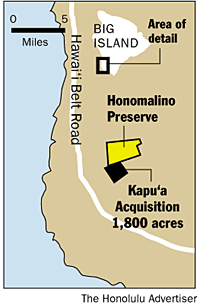By Jan TenBruggencate
Advertiser Science Writer
The Nature Conservancy of Hawai‘i is buying 1,800 acres of Big Island land to expand its Honomalino Preserve, a block of forest land and former pasture on the western slope of Mauna Loa’s Southwest Rift Zone.
The purchase, in an area called Kapu‘a, increases the size of the Honomalino Preserve by almost 50 percent. It lies directly south of the environmental organization’s existing Honomalino land at elevations of 3,000 to 4,500 feet.
The Nature Conservancy estimates the property will be appraised at about $2 million. The sale will be financed through a donation of half the land’s value by seller Leighton Mau, along with financial help from the U.S. Forest Service’s Forest Legacy Program. It was the program’s first grant in the Islands.
In return for the grant, the Forest Service will obtain an easement that will limit the kinds of activities the Conservancy can undertake on the land.
The Conservancy has renamed the expanded preserve its Kona Hema Preserve. The Kapu‘a piece connects the Honomalino parcel to the state’s 25,000-acre Manuka Natural Area Reserve. Between them, they create a chunk of conservation land that is five miles wide at the 4,500 elevation.
"This is 31,000 acres of contiguous forest at different elevations. It is the only leeward wet rain forest in the state, thanks to the size of Mauna Loa," said Kim Hum, the organization’s director of protection.
The Kapu‘a acreage is diverse forest dominated by ‘ohi‘a, koa and tree ferns, and is habitat for native Hawaiian bats, hawks and four species of native forest birds. Hum said it will be managed primarily to protect its biodiversity.
"This area is unique in Kona because it has never been grazed systematically, although there have been a few cattle in there. It is good old-growth forest," she said.
The Honomalino parcel, which has been grazed and logged for koa, is being managed as an example of how best to protect the conservation value of forest land while also obtaining income from it.
"We ... want to develop a model of sustainable koa forestry that will enable other landowners to maintain both the biological and economic value of their lands," said Heather Cole, the Conservancy’s Big Island field representative.
[back to top] |

